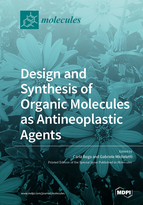Design and Synthesis of Organic Molecules as Antineoplastic Agents
A special issue of Molecules (ISSN 1420-3049). This special issue belongs to the section "Organic Chemistry".
Deadline for manuscript submissions: closed (30 September 2019) | Viewed by 45442
Special Issue Editors
Interests: organic synthesis; bioorganic chemistry; NMR spectroscopy; small molecule synthesis; mechanism elucidation
Special Issues, Collections and Topics in MDPI journals
Interests: organic synthesis; organophosphorus chemistry; heterocyclic chemistry; NMR spectroscopy
Special Issues, Collections and Topics in MDPI journals
Special Issue Information
Dear Colleagues,
The fight against cancer can be dealt with, among different approaches, by synthetizing new compounds with high effectiveness and selectivity to the targeting cancer cells by concomitantly reducing side effects.
In this context, synthetic organic chemistry plays a key role and constitutes a flexible tool since it gives access to a great number of compounds, including antitumoral molecules present in nature, but which are not readily available, as well as novel drugs exhibiting anticancer actions. Through the variation of functional groups or motifs within the organic architecture, it is possible to find and modulate structure–activity relationships and, once the molecular target has been identified, to design new molecules or structural hybrids. Original articles, as well as reviews, regarding recent advancements in the design and synthesis of organic molecules of interest as antineoplastic agents are greatly welcome for inclusion in this Special Issue of Molecules.
Prof. Dr. Carla Boga
Dr. Gabriele Micheletti
Guest Editors
Manuscript Submission Information
Manuscripts should be submitted online at www.mdpi.com by registering and logging in to this website. Once you are registered, click here to go to the submission form. Manuscripts can be submitted until the deadline. All submissions that pass pre-check are peer-reviewed. Accepted papers will be published continuously in the journal (as soon as accepted) and will be listed together on the special issue website. Research articles, review articles as well as short communications are invited. For planned papers, a title and short abstract (about 100 words) can be sent to the Editorial Office for announcement on this website.
Submitted manuscripts should not have been published previously, nor be under consideration for publication elsewhere (except conference proceedings papers). All manuscripts are thoroughly refereed through a single-blind peer-review process. A guide for authors and other relevant information for submission of manuscripts is available on the Instructions for Authors page. Molecules is an international peer-reviewed open access semimonthly journal published by MDPI.
Please visit the Instructions for Authors page before submitting a manuscript. The Article Processing Charge (APC) for publication in this open access journal is 2700 CHF (Swiss Francs). Submitted papers should be well formatted and use good English. Authors may use MDPI's English editing service prior to publication or during author revisions.
Keywords
- antineoplastic
- cancer
- organic compounds
- organic synthesis
- drug design
- biochemistry
- medicinal chemistry
- biological activity








